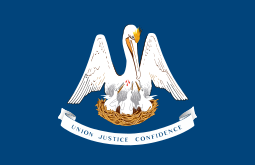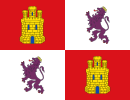Flag of Louisiana
 | |
| Louisianan flag | |
| Use | Civil and state flag |
|---|---|
| Proportion | 7:11 |
| Adopted | Original design: 1912 (current version of design November 22, 2010)[1] |
| Design | Image of a pelican feeding her young with her own blood on a field of azure. Below the pelican, a ribbon displays "Union Justice Confidence" |
The flag of Louisiana consists of a "pelican in her piety", the heraldic charge representing a mother pelican "in her nest feeding her young with her blood[,]"[2] on an azure field with state motto reworded to "Union Justice [and] Confidence." First adopted in 1912,[3] it was last modified in 2010.
Pledge of Allegiance
The Louisiana Pledge of Allegiance is as follows:
"I pledge allegiance to the flag of the state of Louisiana and to the motto for which it stands: A state, under God, united in purpose and ideals, confident that justice shall prevail for all of those abiding here."[4]
History of current flag
Prior to 1861, the state of Louisiana had no official flag, though a flag similar to the present one was often used unofficially.
In January 1861, after declaring secession from the United States but before the formation of the Confederate States of America, Louisiana unofficially used a flag based on the flag of France with seven stars on the blue stripe.
In February 1861, Louisiana officially adopted a flag with a single yellow star in a red canton, with thirteen red, white and blue stripes. This was used through the end of the American Civil War, though the Pelican flag and Flag of January 1861 remained in use unofficially.
The mother pelican's head and outspread wings covering the three pelican chicks nestled below her form a stylized fleur-de-lis, another emblem of similar significance often depicted in Louisiana. This symbol, emblematic of Christian charity (and of Catholicism), is also found on the state seal. During the 19th century it was traditional in Louisiana flags and the state seal for the pelican in her piety to have three drops of blood on her chest.[5] In later years the tradition (on both the state flag and seal) had been haphazardly followed, which was noticed by an eighth-grader at Vandebilt Catholic High School in Houma, who brought this to the attention of his state legislator.[5] In April 2006, the Louisiana State Legislature passed a law which specifies three drops of blood to be depicted on the pelican used in both the state's flag and seal.[6] In November 2010, the current flag design was revealed at a state swearing-in ceremony; state officials said the current design "was required by" the 2006 law and featured a more detailed pelican than the previous design and removed the word "and" from the ribbon.[1]
Historical flags
-
Flag of French Louisiana
-
Flag flown during Spanish Louisiana
-
Cross of Burgundy during Spanish rule
-
Flag of King and Armed Forces of Spanish Empire, used in the Florida Parishes and Spanish Louisiana
-
Flown in Florida Parishes during Indian Reserve
-
Unofficial flag of January 1861
-
Flag of Louisiana Ordinance of Secession Convention
-
Flag of Louisiana of February 1861
See also
References
- ^ a b Anderson, Ed (November 22, 2010). "New Louisiana state flag with bleeding pelican is unfurled". The Times-Picayune|The New Orleans Advocate. Archived from the original on November 24, 2010. Retrieved November 24, 2010.
- ^ Parker, James. "A Glossary of Terms Used in Heraldry". www.heraldsnet.org. Retrieved 2018-04-17.
- ^ Bonham, Milledge L., Jr. “The Flags of Louisiana.” The Louisiana Historical Quarterly 2.1 (1919): 439-446.
- ^ "Louisiana State Pledge of Allegiance". eReferenceDesk. Retrieved April 27, 2018.
- ^ a b Eagle-eyed eighth-grader prompts La. flag legislation, April 6, 2006 New Orleans Times-Picayune Archived September 30, 2007, at the Wayback Machine
- ^ Act 92. La. St. Legis. 2006.











